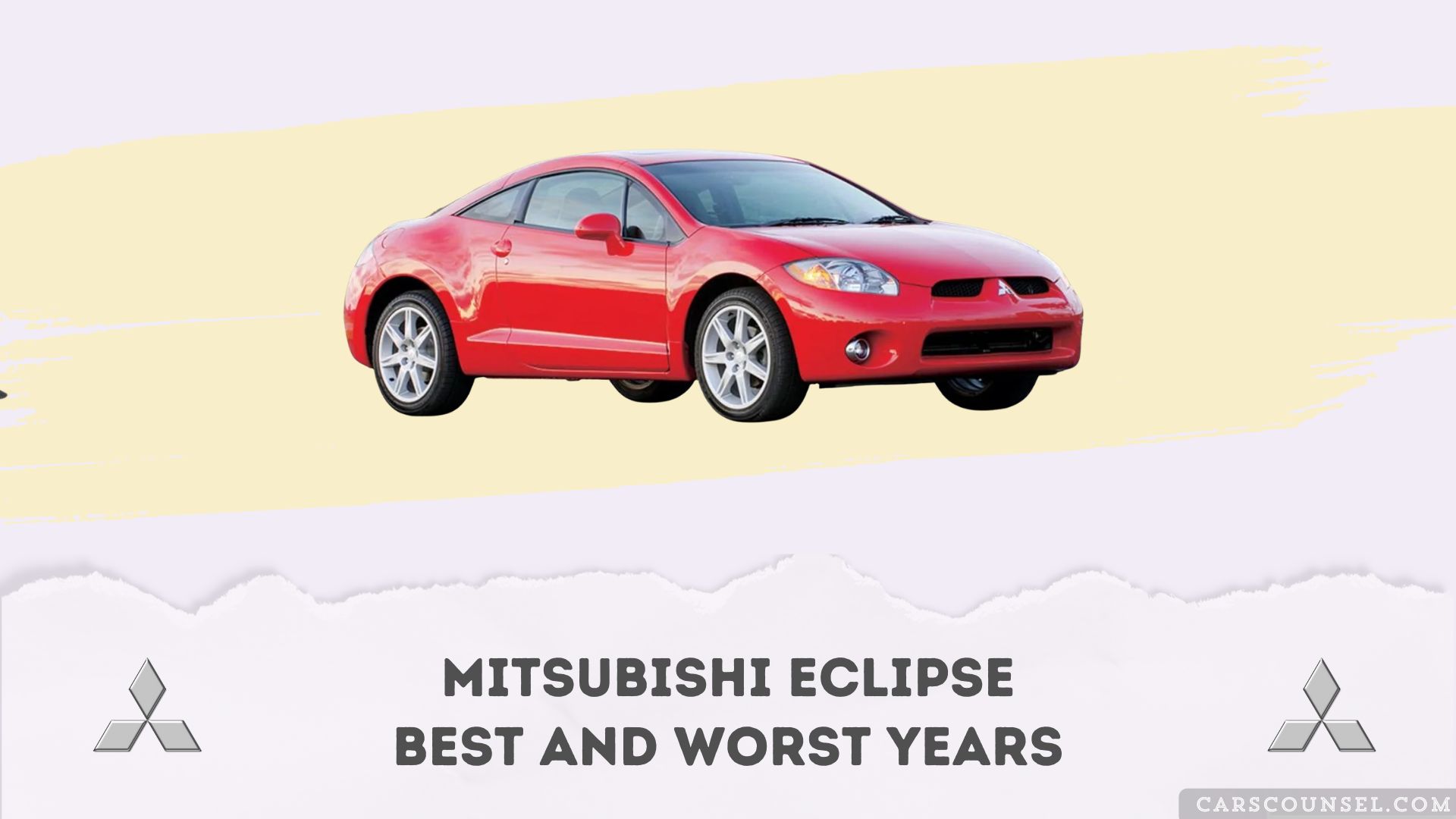As you delve into the Mitsubishi Eclipse’s history, you’ll find that this sports coupe has had its share of highs and lows. From its debut in the late 1980s to its eventual demise in 2011, the Eclipse underwent significant changes, both in design and performance. You’ll notice that certain model years stand out for their exceptional power and handling, while others are plagued by reliability issues. Let’s take a closer look at the Eclipse’s best and worst years, and what made them so notable.

Quick Navigation
Key Takeaways
- The 1995-1999 Eclipse is considered the best year, boasting 210 horsepower and 214 lb-ft of torque in the turbocharged GS-T model.
- Avoid the 1995-1997 models due to faulty transmissions and electrical glitches that lead to costly repairs.
- The 2003-2005 Eclipse models are plagued by faulty engine control modules and malfunctioning oxygen sensors, causing poor engine performance.
- The fourth generation (2006-2011) marked a decline in popularity and sales due to lack of innovation, poor performance, and rising competition.
- The first-generation Eclipse (1989-1994) is prone to rust issues in areas with high humidity or salted roads, affecting the vehicle’s overall value.
First-Generation Eclipse (1989-1994)
The first-generation Eclipse, produced from 1989 to 1994, marked Mitsubishi’s entry into the sports coupe market.
You’ll notice that these early models feature a more angular design compared to later generations.
While they’re still a great option for those on a budget, you should be aware of some common issues.
Rust issues are prevalent in areas with high humidity or salted roads, so inspect the undercarriage and body carefully before purchasing.
Additionally, many owners have customized their Eclipses with body kits, which can affect the vehicle’s overall value.
Be cautious when buying a modified model, and make sure to research the installation quality.
The Golden Age of Turbocharged Performance (1995-1999)
You’re in for a treat with the second-generation Eclipse, which debuted in 1995 with a significant overhaul that earned it the reputation as a performance powerhouse.
The turbocharged GS-T model reached new heights, boasting 210 horsepower and 214 lb-ft of torque. This marked the Eclipse’s turbocharged dominance, solidifying its position as a performance pinnacle.
The Eclipse’s all-wheel-drive system and sport-tuned suspension made it a formidable opponent on the road and track. With its impressive specs and agile handling, the 1995-1999 Eclipse cemented its status as a high-performance icon of the 1990s.
A New Millennium, A New Direction (2000-2002)
You’re now entering a new era of the Eclipse, where Mitsubishi overhauls the design to make it more aggressive and aerodynamic.
At the same time, the powertrain gets a significant boost with upgraded engines and transmissions.
As you venture into this new direction, you’ll notice a more refined and potent Eclipse that’s ready to delve into the competition.
Design Overhaul Ahead
As the calendar flipped to 2000, Mitsubishi’s design team set out on a mission to revamp the Eclipse, bringing it into the new millennium with a fresh aesthetic.
You’ll notice a significant design evolution in these models, with a more aggressive stance and sleeker lines.
The front grille was redesigned, and the headlights were reshaped to give the Eclipse a more modern look.
Mitsubishi’s future projections for the Eclipse were clear: to create a sports car that exuded style and sophistication.
The result was a vehicle that turned heads on the road, boasting a more refined and mature design language.
Powertrain Upgrades Implemented
Mitsubishi’s designers didn’t stop at the exterior; they also poured their attention into the Eclipse’s powertrain.
You’ll notice significant upgrades in the 2000-2002 models. The 3.0-liter V6 engine received refinement tweaks, resulting in a smoother, quieter ride.
The Eclipse GS-T model got a boost from a turbocharger, which increased horsepower to 210. The turbocharger benefits include improved acceleration and amplified overall performance.
These powertrain upgrades made the Eclipse a more competitive player in its class, offering a more engaging drive experience. With these changes, Mitsubishi successfully revitalized the Eclipse’s reputation as a sporty, capable ride.
The Eclipse GS-T: A High-Performance Gem
The Eclipse GS-T model, launched in 1995, brings a new level of performance to the table, boasting a turbocharged 2.0-liter 4G63 engine that pumps out 210 horsepower and 214 lb-ft of torque. You’ll appreciate its racing heritage, which is evident in its responsive handling and acceleration. This turbocharged legacy continues to thrill drivers, making it a sought-after model. Here’s a breakdown of the Eclipse GS-T’s performance:
| Feature | Specification |
|---|---|
| Engine | 2.0-liter 4G63 Turbocharged |
| Horsepower | 210 hp |
| Torque | 214 lb-ft |
| 0-60 mph | 6.4 seconds |
Model Years to Avoid: Quality and Reliability Issues
While the Eclipse GS-T shines with its exceptional performance, other model years have left much to be desired in terms of quality and reliability.
You’ll want to steer clear of the 1995-1997 models, plagued by faulty transmissions that often slip or hesitate to engage. Additionally, electrical glitches were common in these years, causing issues with everything from the radio to the power windows.
These problems led to costly repairs and frustrated owners. If you’re in the market for a used Eclipse, it’s essential to avoid these model years to guarantee a reliable and enjoyable driving experience.
The Eclipse’s Mid-Life Crisis (2003-2005)
Faulty engine control modules and malfunctioning oxygen sensors plagued the 2003-2005 Eclipse models, causing poor engine performance, decreased fuel efficiency, and increased emissions. You might’ve thought Mitsubishi would’ve ironed out these issues, but they didn’t. Instead, they focused on a midlife makeover, which resulted in styling missteps. The new front grille and bumper design received mixed reviews, and the interior updates were minimal. Here’s a breakdown of the issues:
| Model Year | Engine Control Module | Oxygen Sensor |
|---|---|---|
| 2003 | Faulty | Malfunctioning |
| 2004 | Faulty | Malfunctioning |
| 2005 | Improved | Still Malfunctioning |
| 2005 (GS/GT) | Improved | Improved |
A Refinement in Design, But a Loss of Soul (2006-2011)
You’ll notice that the 2006-2011 Eclipse has traded in its angular lines for softer, rounder edges, a design refinement that’s more aerodynamic and visually appealing.
However, this new look comes at the cost of performance, which takes a backseat to comfort and practicality. As you delve into this generation, you’ll find that the Eclipse’s sporty DNA has been toned down in favor of a more mature, refined driving experience.
Softer, Rounder Edges Appear
Mitsubishi’s designers aimed to refine the Eclipse’s exterior by softening its edges and rounding out its contours for the 2006 model year, a move that resulted in a more aerodynamic and visually appealing car.
You’ll notice the facelift controversy surrounding this redesign, as some fans felt the new look lacked the Eclipse’s signature edginess. However, the aerodynamic tweaks did improve airflow and reduced wind noise.
The rounded edges also made the car more approachable, but some argue it lost its sporty soul in the process.
Performance Takes a Backseat
As the Eclipse’s exterior design evolved, its performance capabilities took a step back.
You’ll notice the 2006-2011 models prioritized fuel efficiency over raw power. The 3.8-liter V6 engine produced 263 horsepower, a decrease from the previous generation.
Cost-cutting measures, such as a simpler suspension design, also contributed to the Eclipse’s softer performance. While the interior and exterior design became more refined, the Eclipse’s sporty DNA was diluted.
You’ll feel the difference behind the wheel, as the Eclipse’s agility and responsiveness took a hit. This era’s Eclipse is more commuter-friendly, but enthusiasts might find it lacking.
The Final Years: A Fading Ember of a Once-Bright Star
The fourth generation of the Eclipse, produced from 2006 to 2011, marked a decline in the model’s popularity and sales.
You may have noticed a lack of excitement surrounding the Eclipse during this period. As a result, the model’s Fading Legacy became apparent.
- Lack of Innovation: The fourth generation’s design and features didn’t bring anything new to the table, making it seem like more of the same.
- Poor Performance: The Eclipse’s engine and transmission didn’t receive significant upgrades, leading to subpar acceleration and handling.
- Rising Competition: Other automakers released more competitive models, making the Eclipse seem outdated and less desirable.
When looking at performance cars, make sure to check out our guides on models like the Mitsubishi pajero, Mitsubishi outlander, Mitsubishi Mirage and Mitsubishi Galant. Knowing which model years to target and which to avoid is crucial. Our expert reviews break down these models, providing insights into the years that are celebrated for their engineering excellence and driving satisfaction, as well as those that are best to avoid due to potential issues.

